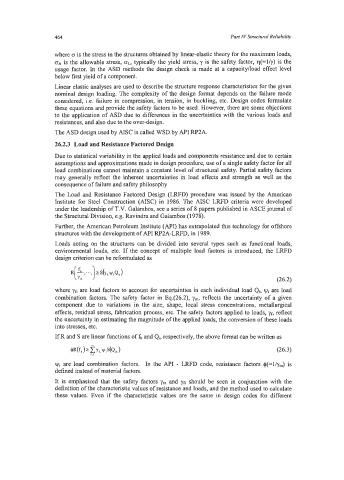Page 488 - Marine Structural Design
P. 488
464 Part IV Structural Reliabiliv
where D is the stress in the structures obtained by linear-elastic theory for the maximum loads,
oA is the allowable stress, DL, typically the yield stress, y is the safety factor, q(=l/y) is the
usage factor. In the ASD methods the design check is made at a capacitylload effect level
below first yield of a component.
Linear elastic analyses are used to describe the structure response characteristics for the given
nominal design loading. The complexity of the design format depends on the failure mode
considered, i.e. failure in compression, in tension, in buckling, etc. Design codes formulate
these equations and provide the safety factors to be used. However, there are some objections
to the application of ASD due to differences in the uncertainties with the various loads and
resistances, and also due to the over-design.
The ASD design used by AISC is called WSD by API RP2A.
26.2.3 Load and Resistance Factored Design
Due to statistical variability in the applied loads and components resistance and due to certain
assumptions and approximations made in design procedure, use of a single safety factor for all
load combinations cannot maintain a constant level of structural safety. Partial safety factors
may generally reflect the inherent uncertainties in load effects and strength as well as the
consequence of failure and safety philosophy
The Load and Resistance Factored Design (LRFD) procedure was issued by the American
Institute for Steel Construction (AISC) in 1986. The AISC LRFD criteria were developed
under the leadership of T.V. Galambos, see a series of 8 papers published in ASCE journal of
the Structural Division, e.g. Ravindra and Galambos (1 978).
Further, the American Petroleum Institute (MI) has extrapolated this technology for offshore
structures with the development of API RP2A-LFWD, in 1989.
Loads acting on the structures can be divided into several types such as functional loads,
environmental loads, etc. If the concept of multiple load factors is introduced, the LRFD
design criterion can be reformulated as
(26.2)
where yfi are load factors to account for uncertainties in each individual load Qi, y~i are load
combination factors. The safety factor in Eq.(26.2), y,,,, reflects the uncertainty of a given
component due to variations in the size, shape, local stress concentrations, metallurgical
effects, residual stress, fabrication process, etc. The safety factors applied to loads, 'yf, reflect
the uncertainty in estimating the magnitude of the applied loads, the conversion of these loads
into stresses, etc.
If R and S are linear functions of fk and Qi, respectively, the above format can be written as
vi are load combination factors. In the API - LRFD code, resistance factors $(=l/-ym) is
defined instead of material factors.
It is emphasized that the safety factors ym and yfi should be seen in conjunction with the
definition of the characteristic values of resistance and loads, and the method used to calculate
these values. Even if the characteristic values are the same in design codes for different

